- Images
- Blog
- Tools
- Questar
- The Questar telescope
- Questar resource links
- Search for Questar info
- 172mm Focal Reducer
- Afocal adapter for point and shoot camera
- Camera adapter lengths
- Camera adapter threading
- Camera connection
- Camera focusing
- Custom counterweight
- Drift Alignment Joy
- Finder Eyepiece Compatibility
- The Questar Moon 1981
- Questar Powerguide II Battery Life
- Questar Zone, How to Service Videos
- Red Dot finder mount for Questar
- Questar Viewing Table
- Wedge mounts
- White light solar filters comparison
- How to
- Get started in astronomy
- Astro RaspberryPi Camera and kin, the ASIAir and StellarMate
- Blind Smart-phone Equatorial Wedge or GEM Polar Alignment
- Camera phone adapter
- Celestron FirstScope with equatorial tripod mount
- Coat Pocket Astrophotography
- Day-lapse Images of Earthshine on the Crescent Moon
- Dobsonian Carrying Case
- DSO Astrophotography without a Telescope
- DSO imaging without a star tracker
- Estimating image resolution
- Lunar Eclipse Photography
- Moon photography - a dozen ways to shoot the Moon
- Meteor shower photography & planning
- Matching image sensor size to telescope resolution
- Narrow band imaging with color cameras
- Planetary Image Workflow
- Print and Display Astrophotography
- Observing
- Events
- More
- About
- Contact
Star Hopping with PS Align Pro Push-To
PS Align Pro can now add Push-To capability to any telescope with just your compatible phone and with a simple easy to make adapter. A star hopping feature makes the most of your phone's electronic compass accuracy, navigating reliably to dim DSO targets via nearby bright stars.
PS Align Pro is familiar tool that I use as a polar alignment aid. Recently I discovered that it has many new capabilities that I'd been ignoring. Green has been added as a built in night mode color. Included are 20 useful calculators for the astronomer and astrophotographer. The extensive astronomical object databases also caught my eye. I realized with the interface from the daytime polar alignment function, PS Align Pro had the pieces for an electronic Push-To device. I contacted the developer, Dimitrios Kechagias, who already had Push-To on his to-do list. He volunteered to proceed, if I would help test the capability for him on the iPhone.
Push-To
A push-to aiming system on a telescope allows you to navigate directly to any celestial object. Your own muscles and a simple move left/right, up/down indicator substitute for power hungry slewing motors and heavy batteries. Precision time, GPS location, and automatic conversion of object location from celestial coordinates to horizon based azimuth and altitude take care of the mental work. Precision encoders measure the required altitude and azimuth angles of the telescope. The required electronics and encoders cost about half the price of a medium size amateur Dobsonian telescope.
Modern smart-phones with GPS, electronic compass and level sensors have the potential to replace these sensors and electronics with an app, but are they accurate enough for practical use? If the push-to not accurate enough to place a dim deep sky object reliably in the initial eyepiece field of view, a painful manual search of near-by locations may be needed.
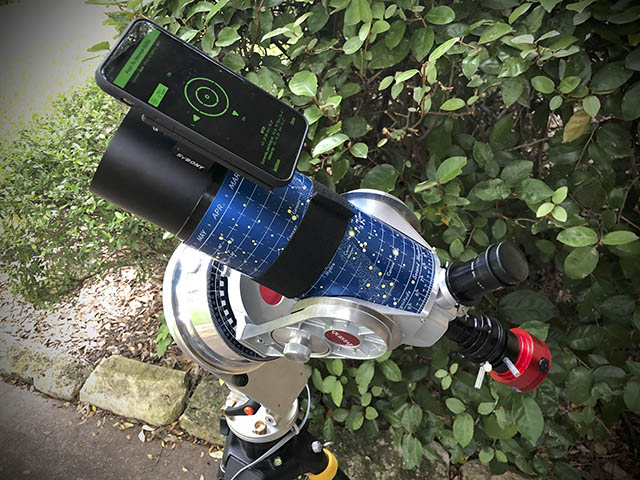
Smartphone Push-To Mount
The Push-To function in PS Align Pro requires that the long axis of the phone be parallel to the optical axis of the telescope. I built a simple adapter to mount my phone in an Orion-Synta finder dovetail which works for all of my telescopes. Construction requires 4 parts:
- a commercial aluminum Orion/Synta dovetail bar (mine came from Svbony on eBay)
- a riser block to provide clearnace for the dovetail clamp screws
- a plywood platform to support the phone
- a flexible TPU case for the phone.
The plywood platform is about an inch short of the phone case size. This gap is placed at the top to allow the TPU case to flex for phone insertion and removal. The case, platform, and riser are all glued together and the aluminum dovetail is screwed into the riser. The final adapter is shown below
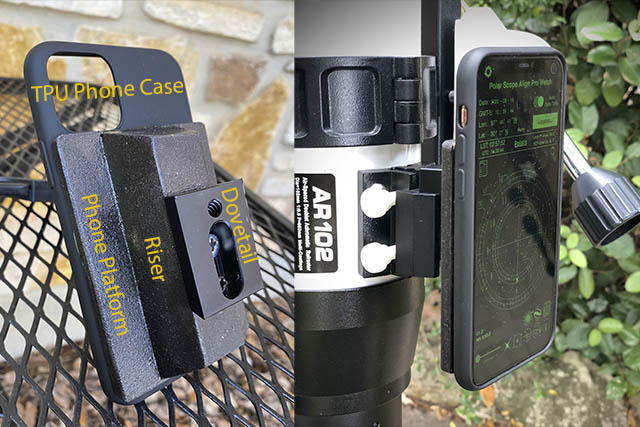
I tested with my Mak on an equatorial wedge as well as an Alt-Az refractor and Dobsonian with my phone mounted in the finder dovetail clamp using the adapter above.

Using Push-To
The electronic Go-To function is found behind the spiral galaxy button on the main PS Align Pro screen. Here you can select the databases to be searched, filters for types of objects, distance from horizon, total and surface brighness, and size. You can also configure units, thumbnails, and coordinates. You can also select how objects will be sorted, including the ability sort by distance from a specific location in the sky. Once these persistent settings are made you proceed to the object search screen by selecting "Show Data".
The Data/Search screen filters results as you type the name or catalog number that you are interested in. Once it is visible, select it to see more information and functions.
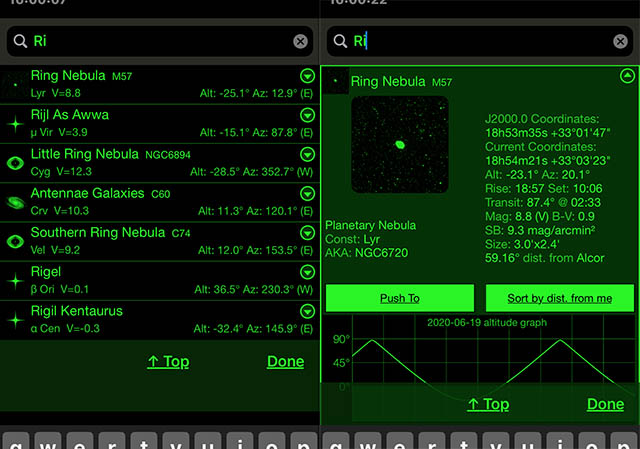
The expanded object data panel allows you to resort the results list by distance from the selected object and to Push-To the object location.
Electronic compass locations are often several degrees off. PS Align Pro has two functions that mitigate this error. The first allows you to correct for compass offset any time you Go-To an object. Make your first target be a bright star. If the star isn't centered in your field of views, center it and press the "Sync To Target" button. This will store the offset for future Go-To targets. You have to repeat this occasionally because periodic phone calibrations can invalidate synced offsets and offsets vary between targets far apart in the sky.
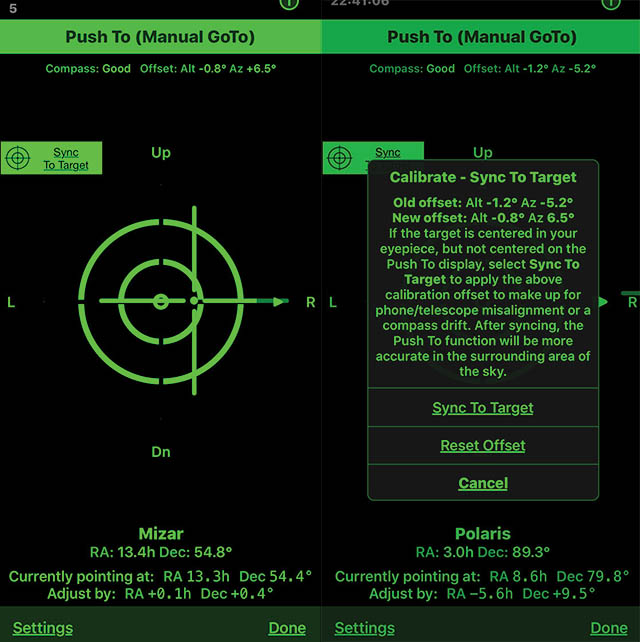
Hop-From
If your target isn't close by your current location, you are offered a choice of "Push to Direct" or "Hop from Star". Hop from Star automatically gives you a few options of a bright star near your target to Hop-to first. This gives you the opportunity to sync any local offset at a bright intermediate target. Once the sync is performed you Go-To the nearby final target. I found that this intermediate step makes the final target location much more accurate, almost always in a 1 degree eyepiece field of view.
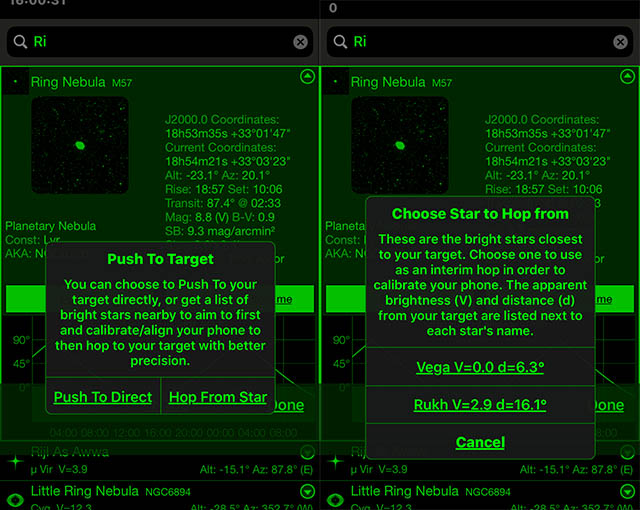
Using Hop-From I was able to locate dim targets in a bright suburban sky like the Whirlpool Galaxy and the Ring Nebula. The image below shows the offset of the Whirlpool after a Hop-From Mizar and Ring Nebula after a Hop-From Vega
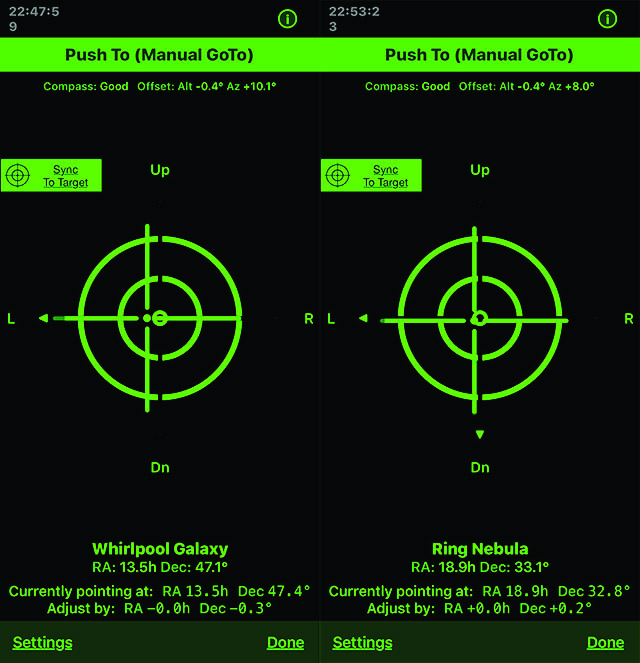
Equatorial mounts
Push-To is most intuitive with an Alt-Az mount. An equatorial fork mount can put my mounted phone at any angle around the telescope axis including upside down. The key is to ignore the arrows on the phone and remember that Left/Right and Up/Down are the directions relative to a person standing behind the scope. You may not be able to see your phone screen standing behind an equatorially mounted telescope. For this, PS Align Pro includes an Apple Watch app which conveniently shows the Push-To Screen on an Apple watch.
Sources of error
PS Align Pro gives an indication of compass calibration accuracy on the Compass and Push-To screens. If it isn't good, try swinging the phone in wide arcs to trigger a re-calibration. Avoid nearby magnets and ferro-magnetic material.
I expected my best results would be with my Explore Scientific AR102 refractor and Questar Maksutov catadioptric scopes which are all alloy and glass. The Vixen Porta II mount I used for my refractor, has a couple of powerful magnets in a hidden compartment to retain Allen wrenches. I had poor results with this mount until I added a steel magnetic shield over the wrench compartment. For my magnetic shield, I cut some steel sheet to match the shape of the rubber tool compartment cover and painted it to match.
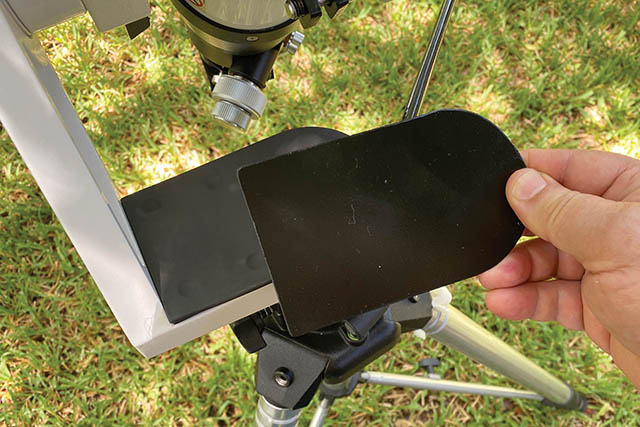
I was pleasantly surprised to find Push-To with my steel tube 200mm Orion Dobsonian worked just fine without any special steps. Everyone has different equipment and locations. If you have compass accuracy problems, simple steps may be able to solve them. Make sure to calibrate your compass by swinging your phone in wide arcs. Consider steps like replacing steel hardware with alloy or stainless steel, magnetic shields, or relocating away from structures with ferromagnetic material like an iron railing.
Conclusion
The PS Align Pro app Push-To function with Hop-From adds useable Push-To capability to almost any scope with little cost and effort.
Content created: 2020-06-23
Comments
![]() Submit comments or questions about this page.
Submit comments or questions about this page.
By submitting a comment, you agree that: it may be included here in whole or part, attributed to you, and its content is subject to the site wide Creative Commons licensing.

Blog
Silver City Heart & Soul Nebulae Revisited
Medulla or Garlic Nebula, CTB1, Abell 85
Nebulae afire off the belt of Orion
City Lights Horsehead & Flame Nebulae
Flaming Star Nebula dark sky vrs city sky face-off
Christmas Tree Cluster and Cone Nebula with more exposure
Christmas Tree Cluster with the Cone Nebula
Horsehead Nebula Face-Off Bortle 2 vrs Bortle 7
California Nebula Face-Off Bortle 2 vrs Bortle 7
Western Veil Nebula from Marfa
Trifid and Lagoon Nebulae Drizzle Stacked
North America and Penguin Nebulae Drizzle Stacked
Return to Coconino Andromeda, M31
Revisiting the Willow House Rosette
Corazón Incendida, the Heart Nebula
Elephant Trunk with the Garnet Star
Balanced HO North America & Pelican Nebulae
The Lagoon & Trifid Nebulas from Marfa
Western Veil Nebula from Marfa
The Great Winter Solstice Conjunction of Jupiter and Saturn
Two days to the Great Jupiter Saturn Conjunction
Worlds Apart, the Jupiter Saturn Conjunction
Raspberry Pi HQ camera first light
Waxing Crescent Moon with earthshine and stars
Vixen Porta II mount adapter or aluminum disk with holes #2
The 2019 ACEAP Expedition to Chile
Universe of Stories: Getting Started in Astronomy
View an Apollo flag on the Moon from Earth?
Apollo 50th is my 24th Flickr Explore Selection
Shooting the video stars - Moon and Jupiter
Ready for a change in perspective
Jupiter and the Galilean Moons through a camera lens
2022 the Solar System in one view
As hard to see as a doughnut on the Moon
Santa Inez miners church Terlingua
Waning gibbous Moon early Christmas Eve
Christmas eve on the eastern limb of the Moon
Mars at 23.3 arc sec with Syrtis Major
BadAstroPhotos Web Site Analytics
Saturn with Pixinsight workflow
Mars Update from Mauri Rosenthal
Waxing Gibbous Moon Terlingua Texas
Io Transit of Jupiter with the Great Red Spot
Not so bad Astro after 2 years
Eyes of the Llama from Urubamba
Moon and Venus over Cusco's El Monasterio
Tiangong-1 Space Station reentry tracking
Apollo - 50 years of human footprints on the Moon, complete!
Waxing Crescent Moon after Astrophotography Meetup
The Great American Eclipse from Above and Below
A million astro photo views on Flickr
Ansel Adams: Moonrise, Hernandez, New Mexico
December Solstice Crescent Moon with Earthshine
January 31 Blue Moon Lunar Eclipse
The Total Solar Eclipse in half a minute
2017 Solar Eclipse from a million miles away
Longhorn Eclipse from a Wyoming Hilltop
Fibs, damn lies, telescopes, and astrophotography
Full Moon before Total Solar Eclipse 2017
Longhorn Crescent Moon from Austin
The Crescent Moon with Jupiter and moons
Eye of the storm 2 - Juno & Jupiter's Great Red Spot
Eye of the storm - Juno & Jupiter's Great Red Spot
A million miles from earth, the Moon and earth east and west
Saturn with Titan, Dione, Tethys, & Rhea
Animated transit of Jupiter by Io
Solar Eclipse 2017 Highway Traffic Map
Mid-South Star Gaze + Questar Meet
Sweet Home Alabama Transit of Jupiter by Io
Update on AutoStakkert on macOS
Diffraction is not the limit for digital images
Teasing life into planetary images
Moon camera comparison: DSLR & planetary cameras
Waning Crescent Moon with Earthshine
1st day of Spring last quarter Moon
Lewis Morris Rutherfurd's Moon
Super Moonrise over Lady Bird Lake
360 Tower pierces the Super Moon
Lisbeth's Birthday Crescent Moon
The Moon and Mars from the Astro Café
Silent and Mechanical Shutter Comparison
Austin's Solar Sidewalk Sun-Day
Another Longhorn Moon over Austin
Jupiter and Venus do a father-daughter dance
Sunset with Mercury, Jupiter, and Venus
Mercury, Jupiter & Venus after sunset
3 months, 92 nations, 3750 visitors, 100,000+ images served
Upcoming Conjunction of Jupiter & Venus
The Perseid Meteor Shower with the Andromeda Galaxy
Waxing crescent Moon from UHD Video
NWS Interactive Digital Forecast Map
M7 the Ptolemy Cluster preview
Five Planets in the Sky at Dusk
Lucky Fat Waning Crescent Moon
Two months, 80 nations, and an embarrassing bug
Saturn with 5 moons: Titan, Rhea, Enceladus, Tethys, & Dione
The nearly full Moon and Saturn with a short tube refractor

 2025
2025
